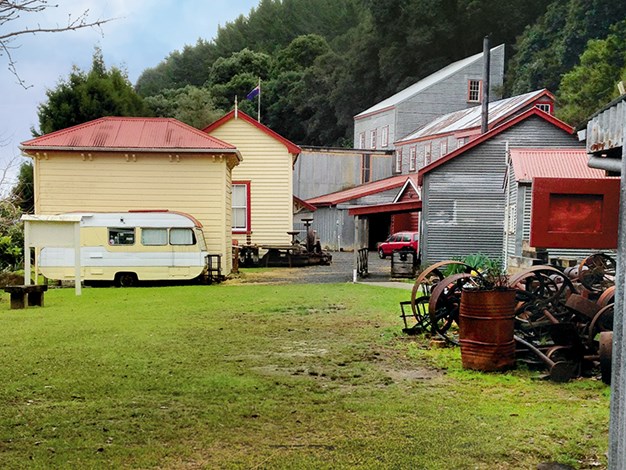 |
|
The Goldmine Experience grounds
|
Since 1970, I’ve driven through Thames nearly every summer heading north to the Coromandel. Occasionally I’ve stopped there to purchase forgotten grocery items at the supermarket or grab takeaways on the way back to Auckland after a beach weekend. It’s taken 50 years to stop and delve deeper into this town, where I found a history of gold.
The first major discovery of gold in the area was in 1867. This brought prospectors flocking and two towns, Grahamstown and Shortland, sprung up. These amalgamated around 1874 to become Thames, and in the late 1800s the town was New Zealand’s largest or second-largest city, depending on what you read, with a population of approximately 18,000. The northern end of Thames is still referred to as Grahamstown. On Thames’ outskirts, heading north on SH25, a black-painted water race that once supplied water to stamper batteries during the gold mining era announces the Goldmine Experience.
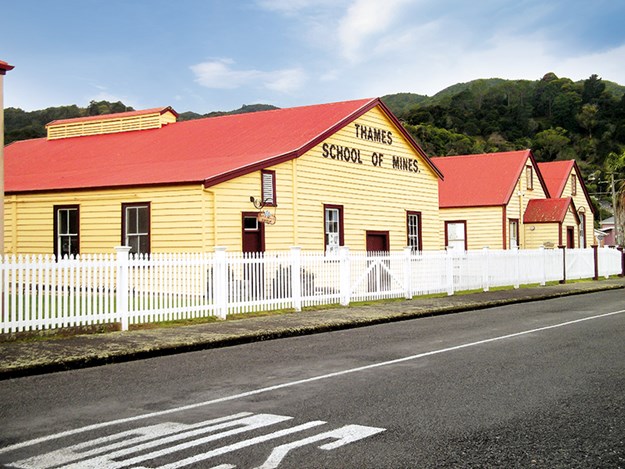 |
|
The School of Mines was established to bring science to bear on the gold recovery process
|
The Goldmine Experience
Run by volunteers, the large corrugated iron structure seen from the road houses a restored 19th century stamper battery from one of the richest mines in the area.
On a guided tour, hard hats donned and torches in hand, we single-filed into one of the original tunnels of the Golden Crown Mine. Cut by Cornish men who were quite short, at 1.65 metres I can stand and don’t quite hit my head. Pick marks from the 1860s can still be seen hewn in the rock sides.
We met Robert, a mannequin, ‘pushing’ a wagon along wooden rails in darkness. Candles gave the only light and sat at ground level detecting oxygen in the air. If a blue flame burned this indicated that gas was present. It must have been frightening when, signifying too much gas, the flame went out, leaving miners to see in darkness.
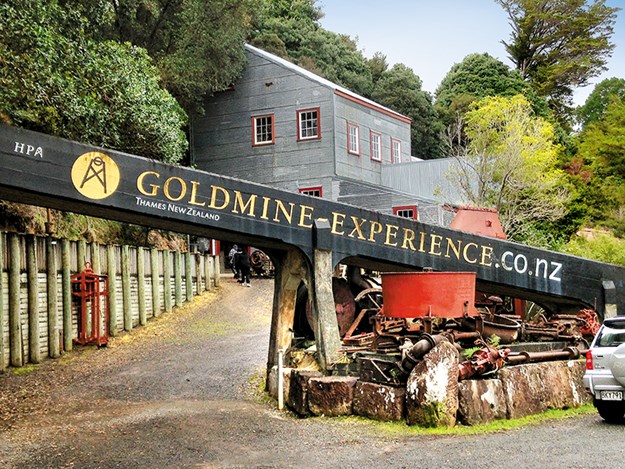 |
|
The Goldmine Experience on SH25
|
Pushing a wagon in the tunnels was an eight-hour job undertaken by apprentice miners to build up body strength to prepare them for work in different parts of the mine. Most tunnels were crooked, following quartz veins where gold and silver were found, but a straight one we passed led to Caledonian Mine on the next hill, which mined the same quartz reef. A tonne of gold was taken from the Caledonian Mine every month. Our guide points out a multi-coloured quartz vein in the rock sides, white being pure quartz, brown containing iron, and blueygrey being gold bearing.
Apparently Thames gold pulled the country out of the Great Depression. Passing boarded up tunnels marked ‘Danger’, walking beneath kauri struts supporting the ceiling and another mannequin ‘chiselling’ at the rock, we emerged back into a light and bright world.
Back at the stamper battery, I learned how gold particles were separated from silver and iron using mercury, chamois, crucibles and heat to become ingots. Earmuffs were required when the stamper started up. Ten metal stamps slammed down, wheels spun and below, on ground level, two boards shook backwards and forwards as water sluiced over them separating ground dirt from gold. The noise was deafening. What did Thames sound like with a number of them operating throughout town?
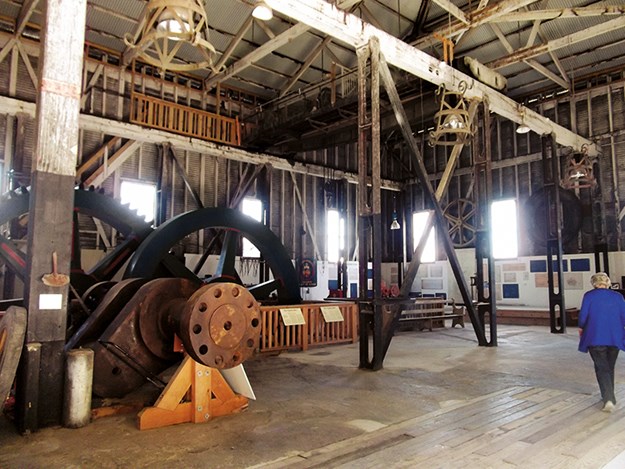 |
|
Bella Street Pumphouse, built to pump water from the goldmines
|
Outside, along with numerous bits of machinery, are a number of other buildings – a boiler room, another housing a single stamper battery and the old morgue relocated from where it stood alongside St George’s Church. Inside what was once the office of Charles Judd, founder of Thames Iron Works, an audiovisual display on the beginnings of Waihi’s Martha Mine is worth watching. It also contains interesting historical photos of Thames – a sea of corrugated-iron roofed wooden buildings, pump houses, and chimneys. There is an opportunity to pan for gold, with volunteers around ready to divulge local history.
Several metres from the Goldmine Experience entrance are two historical sites, Tookey’s Shaft and Caledonian Mine, marked by yellow information boards sponsored by the local Lions Club. There are many of these dotted around Thames marking historical features.
Take a drive up Waiotahi Road, the first street on the left heading south from the Goldmine Experience. This leads to the War Memorial Monument for a view over Thames and the Waihou River snaking away into a green landscape.
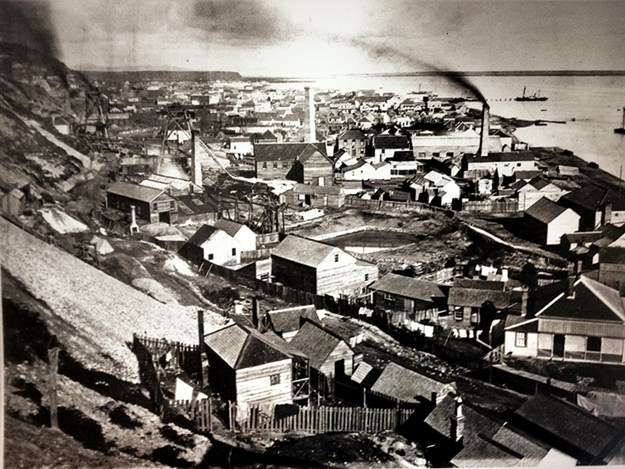 |
|
Old Thames
|
Thames Museum
Back in town, I headed along Pollen Street to its intersection with Cochrane Street, where Thames Museum stands. The museum contained information on the kauri logging era, a display on early Thames transport – when the easiest way to reach Auckland was by steamer – printing machinery from when the town had three newspapers, and household items used by settlers. There’s also a slideshow showing the progress of Thames domestic life.
I thought the highlight was the recycled kauri scale models of the town’s historic buildings. A map showed where they used to stand in town.
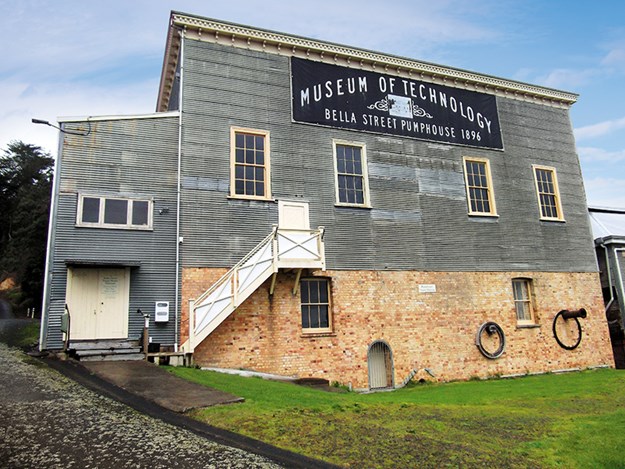 |
|
Bella Street Pumphouse
|
Bella Street Pumphouse
Further up Cochrane Street, Bella Street Pumphouse, built to pump water from the goldmines, is home to recreations of the huge flywheels once here, and original pumping quadrants are still in place over the mineshaft.
If you’re not into engines, it’s still worth a visit for the photographic display of the town in its heyday and of the area’s kauri logging history, plans of where gold mines were located and a working model of the pump and mineshaft.
The cavernous Pumphouse is a fitting place with its cogs, wheels, and iron fittings and artefacts for the Steampunk Ball held here, usually every November.
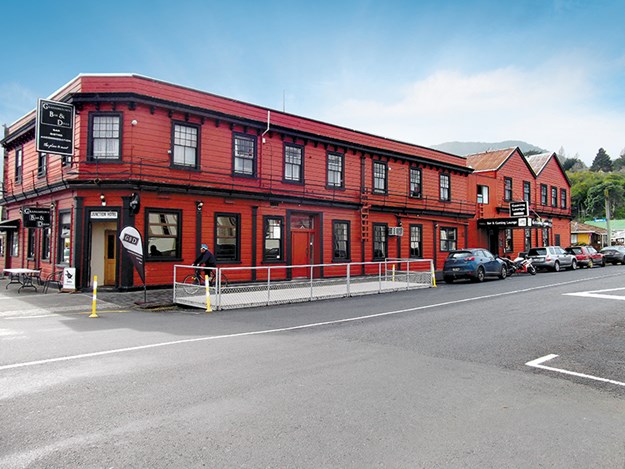 |
|
The Junction Hotel, one of the few gold era hotels still operating
|
Thames Schoolf of Mines and Mineralogical Musuem
Thames School of Mines and Mineralogical Museum is on the corner of Cochrane and Brown Streets, occupying, from 1886, what was once a Wesleyan Sunday School. A Heritage New Zealand category 1 historic place, the school was established to stimulate the stagnating New Zealand economy by bringing science to bear on the gold recovery processes. The aim was to make them more efficient, thus increasing production and revenue.
On a guided tour, I stepped into the old classroom and laboratory; it looked like it was being used right up to the moment it closed in 1954. Desks and chairs face the blackboard, walls are lined with shelves of glass bottles and jars of now inert solutions. Old Bunsen burners and gas taps await.
Gas flames once lit this old, musty smelling, wooden building emanating from beautiful old iron and white glass light shades that are still hanging. In the assaying room, scales and tools are ready for the next rock to be brought in to be tested for its gold content.
The boardroom has a huge kauri table with chairs gathered around, and on glassfronted shelves age-old books, their spines faded, wait to be referred to again.
The Mineral Museum, built in 1900, houses hundreds of labelled rock specimens in a room painted pale blue, green and pink, popular 1950s colours. Outside sits one of the cages that used to deliver men down into a mineshaft.
On a tour you’ll also learn of the land’s history, once a Maori burial site, and in the Rock Shop colourful rocks and crystals from around the world are sold.
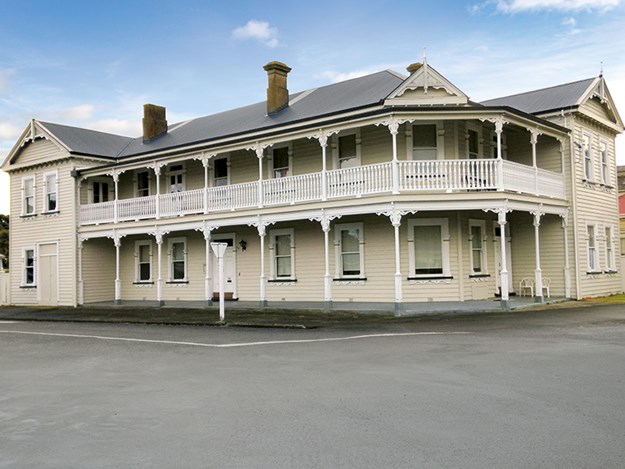 |
|
The once Royal Hotel
|
Discovering the streets of Thames
Thames was once home to over 100 hotels in the gold mining era, with a number dotted along Brown Street. The grand, two-storeyed, verandahed buildings were built in the early 1900s and include the Royal Hotel, Lady Bowen Hotel (now a B&B) and Wharf Hotel. Nearby, the huge corrugated iron and weatherboard buildings on Beach Road house the foundry of A&G Price Ltd. Built in 1871, it once manufactured equipment for the gold mines and is still in operation today.
I passed by the former Court House on my way along Queen Street to the Treasury, next door to the old Carnegie Library. The second of 18 free libraries in New Zealand, it was constructed in 1905 with money donated by Andrew Carnegie, a Scottish-born American businessman who financed over 2500 libraries throughout the United States, Britain, Canada, Australia and other countries. The Treasury houses information on the area’s history and inhabitants, a great place to research any descendants you may have had in the area.
Part of former Grahamstown, the northern end of Pollen Street has many wooden buildings built in the late 1800s, especially between numbers 710 and 756. Looking above the shop frontages on opposite sides of the street, I was reminded of buildings in Wild West towns.
At 709 is New Zealand’s oldest funeral home, Twentymans, established in 1867. Outside the old cottage where the business operates, a board displays a photograph of a 1906 funeral cortege.
In back streets I discovered old wooden miners’ cottages, a window either side of the front door, some with their doorstep adjoining the footpath. Check out Walter, Martha, Kirkwood, Franklyn and Rolleston Streets. Historical walk brochures are available giving the history of some of the older buildings. Or for a guided walking tour of Thames’ heritage sites, contact Russell Skeet, who will bring them alive, such is his passion for the town’s history.
Hours can be spent wandering, dipping into the past and you’ll discover, like me, there’s much more to this town than a main street of shops, a supermarket and takeaways!
FOR MORE INFORMATION
- Historic Places Trust brochures on Historic Grahamstown and Historic Shortland, as well as other historical walk information, can be found at Thames Museum and the i-SITE at 200 Mary Street. There is also a downloadable map available at thecoromandel.com
- Guided tours by Russell Skeet. Email: tsm@heritage.org.nz
- Goldmine Experience: goldminexperience.co.nz
- Thames Museum: thameshistoricalmuseum.weebly.com
- Bella Street Pumphouse/Museum of Technology: bellastreetpumphouse.com
- The Treasury: thetreasury.org.nz
CAMPING
- Dickson Holiday Park is situated 2.7km north of The Goldmine Experience. dicksonpark.co.nz
- Freedom camping is available in and around Thames: Rhodes Park Reserve, Danby Field car park, and at 206 Brown Street. nzmca.org.nz/travel/directory





